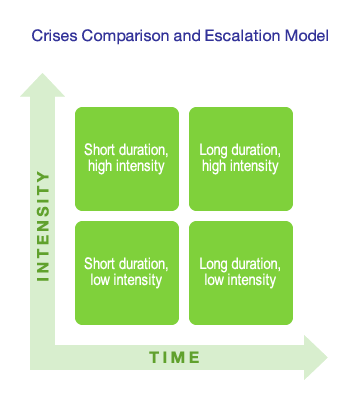All crises are not created equally. Some company mishaps slip quickly out of view while others linger on at high cost for months and months. Explanations for the different outcomes can sometimes be found in the actions or inactions of the afflicted company. But frequently it’s the actions of third parties that seize upon somebody else’s misfortune to advance their own agenda.
Crises can be compared to better understand why some escalate and others do not and to determine what strategies and tactics work best to manage a company’s reputation. The analytical model I’ve developed consists of a four-square matrix with the vertical axis as “intensity” and the horizontal axis identified as “time.” A crisis worsens as it goes up the vertical “intensity” scale or it drags on in “time” along the horizontal axis, as depicted in the following diagram.

The “best” crisis you’ll ever have is one that falls in the lower left quadrant of short duration, low intensity. Generic examples include brief power outages resulting from severe weather, a workplace shooting with no fatalities or an oil pipeline spill that is quickly repaired with minimal damage. A longer term, but still low intensity crisis could be a pipeline break involving a much longer clean up but one which is handled generally well operationally and communicated appropriately by the owner.
As you move up the intensity scale for short duration crises you find tragedies like the fertilizer plant explosion in West, Texas last April and the Carnival Cruise Lines debacle last February. The “Triumph” lost power and propulsion for about a week in the Gulf of Mexico, stranding passengers with little food, toilets that wouldn’t flush and no air conditioning. Both incidents were high profile, but they were not long lasting in the public eye.
The worst crises are typically those of long duration and high intensity, the type that can cripple or even bankrupt a giant corporation. The 2010 BP Macondo tragedy and the 1989 Exxon Valdez oil spill quickly come to mind. And the 2008 collapse of investment banking firm Bear Stearns, while of short duration, is another example of a high intensity crisis; it did not involve the loss of life or environmental damage but the (false) perception of inadequate cash reserves quickly toppled the 85-year-old company.
So what factors intensify a crisis and prolong it? In some instances it’s the circumstances of the incident itself and the swiftness of operational remedies. For example, until BP plugged the well on the ocean floor almost nothing was going to lessen its public relations nightmare.
But in a large number of cases it is the actions of third parties – politicians, competitors, non-governmental organizations, plaintiff attorneys, social media critics – that exploit corporate misfortune to advance their own agenda in a zero sum game. Oil and gas companies are especially vulnerable as Americans generally hold them in low regard. For example, Plaquemines Parish President Billy Nungesser appeared regularly alongside CNN’s Anderson Cooper to bash BP over its handling of the Macondo cleanup. And plaintiff attorneys, for example, are known to file lawsuits against a company within days of an industrial accident, followed by their disclosure of discovery documents and deposition transcripts to embarrass the corporate defendant and raise the cost of settlement. As for the collapse of Bear Stearns, some would argue that Wall Street short sellers not only exacerbated the perception of inadequate cash reserves but may even have instigated it.
This model for comparing crises also has value for understanding the appropriate communication strategies and tactics to use in a given situation; more on that later. For now, I’d like to acknowledge the work of crisis communicator Eric Dezenhall for advancing my thinking on this topic, as well as the feedback from participants in crisis communication training sessions I’ve co-led in the last several months. This crisis training for energy sector professionals is hosted in Houston and elsewhere by London-based Valiant Business Media. For more information, visit: http://vbmuk.com
